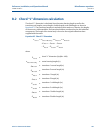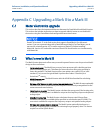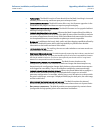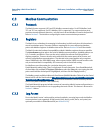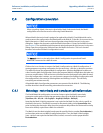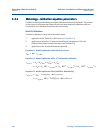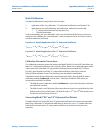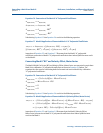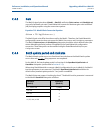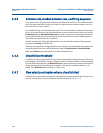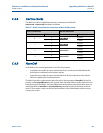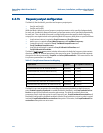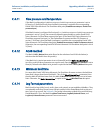
Reference, Installation, and Operations Manual Upgrading a Mark II to a Mark III
3-9000-743 Rev S June 2013
Metrology - calibration equation parameters 305
Mark III Calibration
The Mark III calibration is comprised of two basic steps:
1. application of the “dry-calibration” “A” polynomial coefficients (see Equation C-4)
2. application of one of the following “wet-calibration” methods (or none at all):
• “C” polynomial coefficients (see Equation C-5)
• 12-point linearization
In this methodology, the “dry-calibration” values are set by Daniel at the factory and are not
expected to be modified; the “wet-calibration” values are expected to be set as the result of a
user flow calibration (if desired).
Equation C-4 Mark III Application of the “A” Polynomial Coefficient
Equation C-5 Mark III Application of the “C” Polynomial Coefficient
Calibration Parameter Conversions
The calibration parameter conversion involves the Mark II British Gas Factor (BG) and either the
Mark II “A” polynomial coefficients or the (Velocity Offset, Meter Factor) depending upon which
values were used. If the Mark II “A” polynomial coefficients were not equal to [0,1,0,0] nor
[0,0,0,0], then the Mark II used the “A” polynomial coefficients; otherwise it used the
Velocity Offset and Meter Factor. The conversions are described in detail below.
If the Mark II meter did not utilized piece-wise linearization (PWL), then the Mark III meter’s
calibration method (CalMethod) is set to ‘None’. Otherwise, the Mark II PWL values are
converted for the Mark III as follows:
• The Mark III meter’s calibration method (CalMethod) is set to select the piece-wise linear
wet-calibration method.
• The Mark II meter’s ten PWL points (flow rate and meter factor) are copied directly to the
Mark III meter’s first ten PWL points. The Mark III meter’s 11
th
and 12
th
PWL points are set
for flow rate of 0 and meter factor of 1.
Converting Mark II “BG” and “A” Polynomial Coefficients
The Mark II British Gas Factor (BG) and “A” polynomial coefficients are converted to equivalent
Mark III dry-calibration “A” polynomial coefficients as shown in Equation C-6 below. Note that
both the forward and reverse “A” polynomial coefficients are converted using the same
equations.
v
DryCal
A
0
A
1
v+
AvgWtd
A
2
v
AvgWtd
2
A
3
v
AvgWtd
3
++=
v
WetCal
C
0
C
1
v+
DryCal
C
2
v
DryCal
2
C
3
v
DryCal
3
++=



